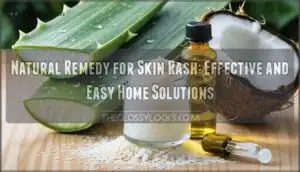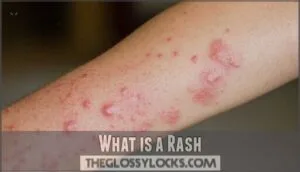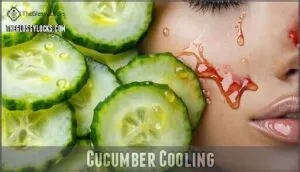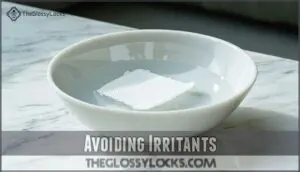This site is supported by our readers. We may earn a commission, at no cost to you, if you purchase through links.

Start with aloe vera—it’s like a cooling blanket for irritated skin. An oatmeal bath can calm redness and ease itching, thanks to its anti-inflammatory properties.
Coconut oil also works wonders, moisturizing while reducing flare-ups. Tea tree oil, diluted properly, fights bacteria and keeps things clean, though it’s not for sensitive skin.
Whatever you try, keep the area clean and avoid scratching—it only makes things worse. Curious about easy methods for long-term relief? There’s more you might want to check out.
Table Of Contents
- Key Takeaways
- What is a Rash
- Natural Remedies
- Home Treatment Methods
- Preventing Skin Rashes
- When to Seek Help
- Frequently Asked Questions (FAQs)
- What is the best natural remedy for rashes?
- Will apple cider vinegar get rid of a rash?
- What clears up skin rashes?
- How does diet influence rash healing speed?
- Are natural remedies effective for sun-induced rashes?
- What is the role of hydration in rash recovery?
- Do weather changes impact natural remedies effectiveness?
- Conclusion
Key Takeaways
- You’ll find quick relief with aloe vera gel, which provides cooling effects and healing properties to soothe irritated skin and reduce inflammation without harsh chemicals.
- You can create a soothing oatmeal bath using colloidal oatmeal or ground oats in warm (not hot) water for 15-30 minutes to calm irritation and leave a protective layer on your skin.
- You should keep the affected area clean, avoid scratching, and use natural oils like coconut oil for its anti-inflammatory powers, but always patch test first to ensure you won’t experience sensitivity.
- You’ll need to seek medical help if your rash is spreading quickly, accompanied by fever or breathing difficulties, or hasn’t improved with home treatments, as these could indicate a more serious condition.
What is a Rash
A rash is any noticeable change in your skin’s color, texture, or appearance, often caused by irritation or an underlying condition.
A rash signals your skin’s cry for help—notice changes early to soothe irritation and restore your skin’s natural balance.
It can range from mild redness to itchy, inflamed patches, sometimes making daily life a bit uncomfortable, and this can be considered a rash with itchy symptoms.
Types of Rashes
Skin rash types vary, and understanding them helps in finding the right skin rash treatment.
Here are five common ones:
- Contact Dermatitis – Triggered by irritants or allergens.
- Atopic Eczema – Chronic redness and itching.
- Psoriasis Symptoms – Scaly, thick patches.
- Heat Rash – From blocked sweat ducts.
- Hives Causes – Often linked to allergies or stress.
Signs and Symptoms
A rash can show up in different ways: redness, itching, or even blister formation.
You might notice the itch intensity changes depending on the affected areas.
Some rashes bring mild discomfort, while others cause noticeable pain levels.
Here’s a quick breakdown:
| Symptom | Description |
|---|---|
| Itch Intensity | Mild to severe itching |
| Rash Appearance | Red, swollen, or bumpy skin |
| Blister Formation | Fluid-filled or raised bumps |
| Pain Levels | Ranges from none to sharp discomfort |
Causes and Risk Factors
Rashes appear for many reasons, often tied to your unique skin and surroundings.
Allergens, irritants, medications, and even stress can trigger reactions.
- Allergens like pollen or pet dander can irritate sensitive skin.
- Environmental factors, such as pollution or extreme weather, may worsen flare-ups.
- Genetic predisposition raises your risk if family members suffer.
- Medication side-effects sometimes cause rash outbreaks.
- An overactive immune system can misfire, reacting unnecessarily.
Shaving with dull razors can also cause irritation and razor bumps, which may be related to allergens, irritants, and other environmental factors.
Natural Remedies
You can ease skin rashes using natural remedies that soothe irritation and promote healing.
Ease skin rashes naturally with soothing remedies that calm irritation, restore comfort, and promote gentle, effective healing for your skin.
Simple options like aloe vera, oatmeal baths, and coconut oil offer gentle, effective relief without harsh chemicals.
Aloe Vera Benefits
Ever wonder why aloe vera is such a go-to for skin rash relief?
Its natural cooling effects soothe irritation fast, while healing properties work wonders on scar reduction.
This skin rash remedy isn’t picky—it helps with almost all rash types.
Regular aloe application improves hydration and acts as a gentle, natural skin relief you can trust anytime, with its natural cooling effects and healing properties.
Oatmeal Baths
After soothing with aloe, an oatmeal bath works wonders to calm irritation.
Use colloidal oatmeal or ground oats, and keep the bath temperature warm but not hot to avoid aggravating sensitive skin.
Soak for 15–30 minutes to refresh and hydrate.
Many people buy pre-made bath products for convenience.
Pat skin dry gently, leaving a protective layer behind—this simple, natural remedy helps skin feel soothed and nourished.
Coconut Oil Uses
Oatmeal helps soothe irritation, but coconut oil offers added versatility for skin care.
Its anti-inflammatory powers can calm skin rash and redness while moisturizing dry or sensitive skin. Apply a thin layer to affected areas, but patch test first—some skin types may react.
Some users experience coconut oil rash after topical application. Coconut oil benefits also include antimicrobial protection, but avoid using it on acne-prone skin.
Tea Tree Oil Applications
Coconut oil is fantastic, but tea tree oil brings its own charm to natural remedies for a skin rash.
Its antimicrobial properties soothe eczema and insect bites when diluted properly. Tea tree oil also has anti-inflammatory properties that can help reduce skin irritation.
Try blending with a carrier oil for safer use.
- Key tips:
- Follow proper dilution ratios.
- Avoid broken skin.
- Apply post-shower.
- Limit use if sensitive.
- Skip oral use—it’s toxic!
Home Treatment Methods
You can ease skin rashes with simple, natural methods right at home. These treatments, like cold compresses and soothing oils, help calm irritation and promote healing.
Cold Compress Technique
A cold compress is great for calming inflammation and easing itching caused by a skin rash.
Wrap ice or frozen peas in a soft cloth to protect your skin. Apply for 10-15 minutes, repeating 3-4 times daily. If you lack ice, damp, chilled washcloths work too.
Many seek solutions for skin irritation relief when dealing with rashes.
| Compress Types | Duration | Frequency | Alternatives |
|---|---|---|---|
| Ice | 10-15 mins | 3-4 times/day | Frozen peas |
| Washcloth | 10-15 mins | 3-4 times/day | Chilled towel |
| Gel Pack | 10-15 mins | 3-4 times/day | Cool sponge |
The use of a cold compress can provide relief from skin irritation, and it is essential to apply it correctly to achieve the best results.
Banana Peel Remedies
Banana peels aren’t just food waste—they’re handy for rash home treatment.
Rich in antioxidants and fatty acids, they calm irritated skin and relieve rashes.
Simply refrigerate a peel, then gently rub its inside on affected areas for 10 minutes.
Repeat daily for skin irritation cure.
Benefits include soothing eczema and psoriasis, but stop if irritation worsens.
Cucumber Cooling
Cucumber benefits go beyond salads—it’s a cooling superstar for rashes.
Simply slice a chilled cucumber and place it on irritated skin.
Its natural hydration and soothing effect can calm redness and itchiness, providing a natural and effective remedy.
Cooling duration? About 10-15 minutes.
This rash home treatment works for all skin types, plus, it’s one of the easiest skin rash remedies.
Honey Applications
Honey’s natural remedies work wonders for skin irritation and inflammation. Its antimicrobial benefits help with diaper rash, dermatitis relief, and psoriasis treatment.
For soothing relief, the following steps can be taken:
- Dab raw honey onto the rash, leave for 20 minutes.
- Rinse with lukewarm water.
- Use as a honey moisturizer daily.
- Try it on eczema patches overnight.
- Choose medical-grade honey for best results.
Honey can also help exfoliate, offering natural skin renewal through methods like a natural skin renewal.
Preventing Skin Rashes
You can prevent skin rashes by adopting simple habits that keep your skin healthy and irritation-free.
Focus on good hygiene, avoid known irritants, and protect your skin with the right products and clothing.
Good Hygiene Practices
Keeping clean is key to rash prevention.
Wash daily with mild soap and lukewarm water—avoid hot washes that dry skin.
Pat dry instead of rubbing, protecting sensitive areas.
Wear absorbent clothing to stay dry and cool.
Prioritize hygiene to prevent allergies and skin issues, emphasizing cleanliness importance.
Proper habits make a healthier lifestyle easier to maintain.
| Do | Don’t |
|---|---|
| Use mild soap | Use harsh detergents |
| Wash with lukewarm water | Take hot showers |
| Pat skin dry | Rub skin vigorously |
| Wear breathable fabrics | Wear tight synthetics |
Moisturizing Tips
Hydrating your skin regularly helps prevent rashes and keep it healthy.
Focus on:
- Fragrance-free options: Avoid irritants by choosing unscented, gentle creams.
- Best ingredients for your skin type: Look for natural remedy staples like shea butter or almond oil.
- Application frequency: Moisturize damp skin twice daily, locking in hydration for lasting softness and irritation prevention.
Avoiding Irritants
Your skin deserves care, so steer clear of irritants. Choose fragrance-free products and hypoallergenic soaps to reduce skin sensitivity.
Be mindful of fabric choices—cotton is gentle on allergies. Avoid allergen triggers and limit chemical exposure to prevent skin rash causes.
Consider incorporating gentle cleansers into your routine for sensitive skin. Understanding these steps isn’t just a skin irritation cure, it’s a smart prevention strategy.
Protective Gear
Protect your skin from rashes by using the right gear.
Gloves and goggles help during chemical handling, while long sleeves and hats offer sun protection.
In the workplace, safety gear reduces exposure to irritants.
Sports equipment and breathable fabrics prevent friction, and garden wear shields against plants causing rashes.
These simple measures are effective for skin rash prevention and remedies.
When to Seek Help
You shouldn’t ignore a rash that’s getting worse, spreading quickly, or causing severe discomfort.
If it’s sticking around for weeks, or you notice symptoms like fever or trouble breathing, it’s time to see a doctor.
Severe Symptoms
If you’re experiencing intense pain, breathing difficulty, a spreading rash, high fever, blistering wounds, or swollen lymph nodes, these are severe symptoms that shouldn’t be ignored.
Such signs might indicate a serious condition needing immediate care.
Seek medical attention promptly, especially if the rash disrupts daily life or worsens quickly.
Don’t wait—your health matters, and it’s crucial to address these symptoms to prevent further complications, as they could be signs of an underlying issue that requires immediate care.
Worsening Conditions
If your rash isn’t improving or starts worsening, pay attention.
Watch for infection signs like pus or warmth, treatment failure despite remedies, or scarring risks from constant inflammation.
Chronic rashes that linger may indicate complications arise needing medical attention.
Seek help when:
- Severe symptoms persist beyond relief.
- Spreading redness affects new areas.
- Swelling worsens beyond the initial rash.
Systemic Symptoms
If your rash appears with fever, chills, or fatigue, these might hint at internal infections or an autoimmune response, not just allergies or simple inflammation.
Organ involvement or medication side-effects can also be serious culprits. Don’t ignore these symptoms—they could signal underlying diseases needing urgent care.
Persistent itching or worsening redness? It’s time to consult a doctor.
Unknown Causes
Sometimes, skin rash causes and effects feel like solving a mystery. If you’ve tried every skin irritation cure, but nothing works, it might be due to hidden triggers like environmental factors, an immune response, or even genetic predisposition.
Diagnostic challenges, like identifying skin allergies, often require tests such as allergy testing. Lifestyle factors, such as chronic stress contribute to skin issues.
For chronic or baffling rashes, consulting a specialist makes sense.
Frequently Asked Questions (FAQs)
What is the best natural remedy for rashes?
Try aloe vera gel—it’s a classic remedy for soothing redness and reducing inflammation.
Apply it fresh, let it sit 15 minutes, then rinse.
You’ll feel relief fast, and it’s gentle enough for sensitive skin.
Will apple cider vinegar get rid of a rash?
Picture vinegar touching irritated skin—it might sting more than soothe.
While apple cider vinegar has antimicrobial benefits, its acidity can irritate rashes.
Always dilute it and proceed cautiously to avoid making matters worse, considering its potential to irritate.
What clears up skin rashes?
You can clear up skin rashes by keeping the area clean, using gentle moisturizers, and applying natural remedies like aloe vera or colloidal oatmeal.
Avoid irritants, wear breathable clothes, and seek medical advice for persistent symptoms, which can help prevent further issues with skin rashes.
How does diet influence rash healing speed?
Your diet plays a key role in rash recovery.
Eating anti-inflammatory foods like leafy greens, berries, and fatty fish speeds healing.
Avoid processed foods and sugar, which can worsen inflammation and slow the process, is not the best choice, instead, focus on anti-inflammatory foods.
Are natural remedies effective for sun-induced rashes?
Sunburned skin screams for soothing solutions.
Natural remedies like aloe vera, cool compresses, and oatmeal baths ease inflammation, itching, and redness.
These methods don’t cure severe cases but offer quick, comforting relief for mild sun rashes.
What is the role of hydration in rash recovery?
Staying hydrated helps your skin heal faster by keeping it moisturized from within.
Proper hydration reduces dryness, supports skin repair, and flushes out toxins.
Drink plenty of water to promote a healthier, rash-free recovery.
Do weather changes impact natural remedies effectiveness?
Like a fickle friend, weather changes can impact natural remedy effectiveness.
Heat increases absorption but humidity may reduce it.
Cold weather can diminish herbal potency while dry conditions may enhance oil-based treatments.
Conclusion
Like a gentle wave washing away discomfort, natural remedies for skin rash offer relief without harsh chemicals.
You’ve now got several options in your healing toolkit—from soothing aloe vera to anti-inflammatory oatmeal baths.
Remember to maintain good hygiene, avoid irritants, and know when professional help is needed.
With consistent application and preventive measures, you’ll find that these natural remedy for skin rash solutions can effectively manage symptoms and restore your skin’s health.
- https://www.webmd.com/diet/apple-cider-vinegar-and-your-health
- http://www.mayoclinic.org/symptom-checker/skin-rashes-child/related-factors/itt-20009075
- http://www.healthcommunities.com/rash/types.shtml
- https://www.ncbi.nlm.nih.gov/pmc/articles/PMC6301073/
- https://www.aad.org/public/everyday-care/itchy-skin/itch-relief/relieve-itchy-skin














